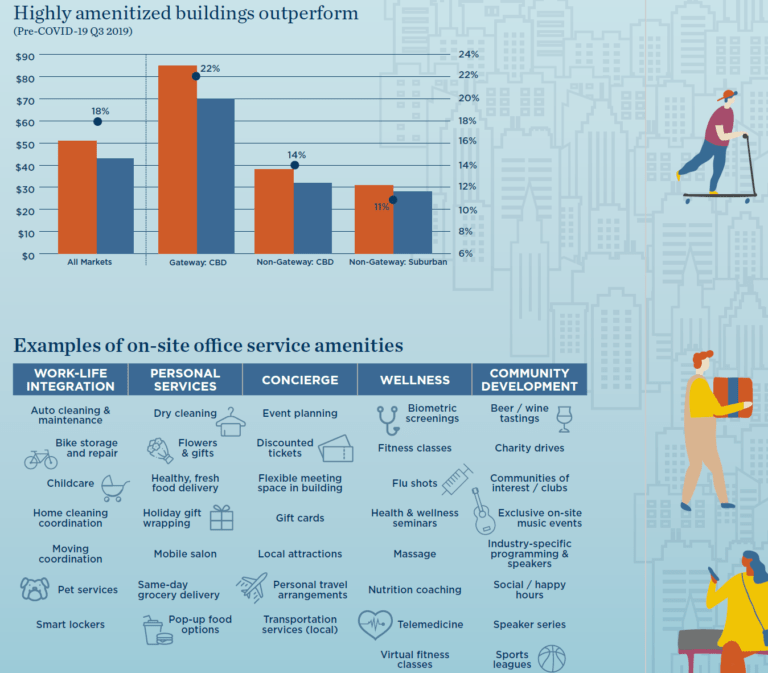Over the past decade, amenities in and around office buildings had grown in quantity, popularity, and creativity. The proliferation of office amenities was the outcome of several trends coalescing into a perfect storm of office real estate transformation: stiff competition for in-demand talent, supply- demand mismatch in employment, demographic shifts, higher-than-ever expectations from users, technological advances changing how and where work can be done, and a wealth of new, high-quality office development. As work can be done more easily from anywhere, landlords and occupiers were creating desirable and inspiring spaces where employees actually “wanted” to work. And overall, this strategy had paid off for both investors and occupiers:-
Investors: Study of 250+ office buildings in North America showed that pre-COVID-19 highly amenitized buildings had an 18.3 percent rent premium compared to the surrounding sub-market prior to the onset of COVID-19. The premium was even more substantial in the central business districts of gateway markets (+21.6 percent).
Occupiers: Leading into the current recession, the biggest concern among CEO’s regardless of sector or geography had been attracting and retaining talent.
The workplace had become an extension of corporate culture, offering one of the first impressions for potential new hires and driving connection to the corporate brand and culture for existing employees. One of the most problematic impacts of the COVID-19-induced work from home has been that half of employees have struggled to connect with their company culture. COVID-19’s impact on amenities in the short term in the face of COVID-19, the initial challenge for employers and landlords has been how to create environments that attract workers back into the office while ensuring the proper health and safety measures are being taken. This is not only true for the workplace, but is also a concern for the office lobby, spaces in and around the office building, and the commute itself. Much of the return to the office timeline revolves around the types of amenities designed to make life safer and more manageable while COVID-19 continues to be a concern. However, they do not necessarily speak to what a post-COVID-19 world will look like for office amenities. In fact, these short-term solutions are often just ‘table stakes’ for getting workers back into the office space.
Expanded personal space around workstations
Enhanced cleaning protocols
Improved indoor environmental quality
Covering out-of-pocket transportation costs

What changes in the long-term?
For good reason, the majority of thought leadership over the past six months has been focused on managing distributed teams through a global pandemic and subsequently how-to renter the workplace safely and effectively. However, now is the time to understand what the future of work will look like once the worst of the pandemic is behind us. First, the office’s demise is greatly exaggerated right now. Certainly, work from home and remote work will continue to be a larger part of economies around the globe. Even prior to the current recession, global office space utilization was approximately 60 percent on any given day. Post- COVID-19, we will see a growth in firms offering formal work from home policies. A recent employer survey found that 83 percent of companies plan to allow more people to work from home on the other side of the pandemic. This will inevitably impact the office real estate market. In fact, current estimates peg the impact of working from home on office demand between 3-17 percent over the next decade. The drag on aggregate demand is expected to be lower across Asia Pacific (five percent or less) and higher across Europe and North America (15-17 percent). However, countless CEOs have stated that even if workers are in the office less than they were pre-COVID-19, the benefits of working together face-to-face remain critical for innovation, work quality, productivity, relationship building, culture and professional development. With 70 percent of workers indicating they would like to work in the office most of their week once COVID-19 is no longer an issue (and only 12 percent desiring 100 percent virtual work), the office will continue to directly impact the majority of employees on any given day. Second, what the office offers workers will be more important in a post-COVID-19 world, not less important. The current crisis has confirmed that certain types of work are equally possible inside or outside of the office. As a result, the office space and its amenities will need to be retooled to support the functions that happen best in the confines of the office. Differentiation through amenities will be more vital for landlords and occupiers seeking to create vibrant spaces for employees who now have more options for where and how to work. Given that many people are generally productive at home, the primary purpose of the office moving forward will be to support collaboration, reinforce culture, train and develop team members, and drive social interaction. The office its work spaces, amenities and services will need to be redesigned to support these efforts more directly. Many of the pre-COVID-19 trends in amenities and services will continue, accelerate or shift when workers return to the office.
www.adnans.ca | 647-545 1174 | mian@adnans.ca





